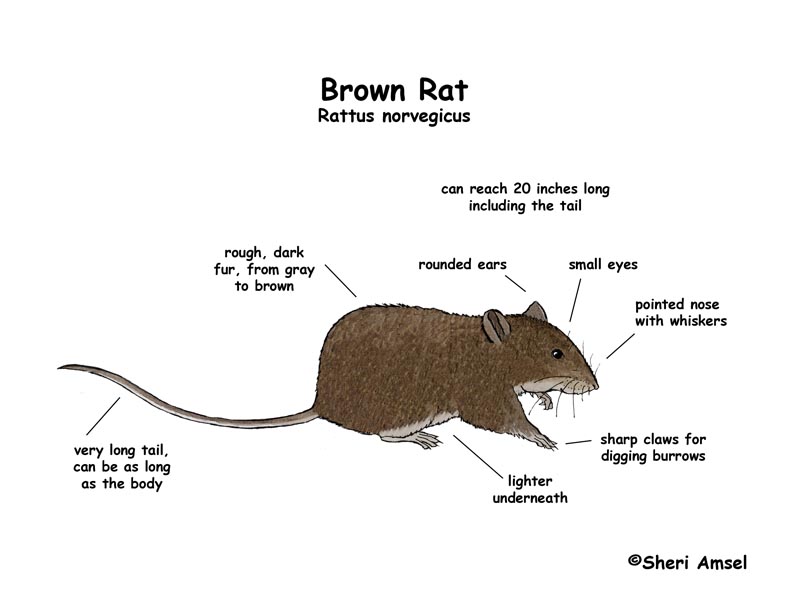

They are found on all the continents in the world except Antarctica. They are thought to have come from Asia and spread via ships throughout the world.
They are found anywhere people live. They may have originally lived in forests and fields, but they have adapted very well to very urban habitats and in fact seem to do extremely well in their new habitats. Anywhere there is refuse (garbage) like dumps and sewers provides food and shelter to rats.
They have rough, dark fur, from gray to brown and are lighter underneath. They can reach 20 inches long including the tail (the tail can be as long as the body) and weigh ¾ of a pound. They have a great sense of smell.
They are active at night (nocturnal) hunting for food and bringing things back to their burrows. They dig large, complex burrows and make nests of foliage and trash. They live in groups, often near water, and are good swimmers.
They are considered omnivores and scavengers and will eat almost any organic matter.
They are eaten by cats, dogs, coyote, wild mammals, birds of prey, and man.
Females are pregnant for 3 weeks (gestation) and have about a half dozen young (though a dozen are possible!). They breed year-round, having litters every couple of months.
They rarely live more than 1 year in the wild, but can live up to 4. They are listed as Lower Risk - least concern.
Kingdom: Animalia
Phylum: Chordata
Subphylum: Vertebrata
Class: Mammalia
Order: Rodentia
Suborder: Myomorpha
Family: Muridae
Subfamily: Murinae
Genus: Rattus
Species: Rattus norvegicus
When you research information you must cite the reference. Citing for websites is different from citing from books, magazines and periodicals. The style of citing shown here is from the MLA Style Citations (Modern Language Association).
When citing a WEBSITE the general format is as follows.
Author Last Name, First Name(s). "Title: Subtitle of Part of Web Page, if appropriate." Title: Subtitle: Section of Page if appropriate. Sponsoring/Publishing Agency, If Given. Additional significant descriptive information. Date of Electronic Publication or other Date, such as Last Updated. Day Month Year of access < URL >.
Amsel, Sheri. "Rat (Brown)" Exploring Nature Educational Resource ©2005-2024. December 13, 2024
< http://exploringnature.org/db/view/473 >

